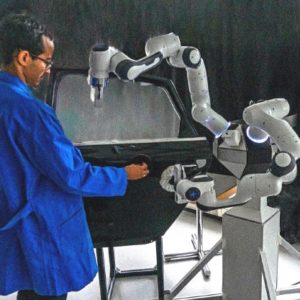![]() Dinmukhamed Zardykhan, Petr Svarny, Erfan Shahriari and Sami Haddadin
Dinmukhamed Zardykhan, Petr Svarny, Erfan Shahriari and Sami Haddadin
Collision Preventing Phase-Progress Control for Velocity Adaptation in Human-Robot Collaboration
Proceedings of the IEEE/RAS International Conference on Humanoid Robots 2019
Abstract
In this paper, we present two approaches for collision prediction, the so-called Impulse Orb, Prognosis Window, and their application in collision-preventing human-robot interaction. Both approaches dynamically determine the possible robot induced collisions with detected human key-points via a novel velocity modulating approach, in which the phase progress is adapted while the desired robot trajectory remains intact. Proposed approaches increase the effectiveness of human-robot collaboration. While guaranteeing collision prevention, these methods avoid over-conservativeness. Two approaches, as well as their fusion, are designed intuitively with the associated parameters kept minimalistic. This allows high adaptiveness to various scenarios and is highly applicable in the use cases of service robotics, such as humanoids. In contrary to most State of the Art approaches the Impulse Orb and Prognosis Window approaches do not lead to abrupt motions. Both approaches provide gradual velocity reduction and therefore make the behavior of the robot better understandable for the human counterpart. The methods are demonstrated on a Franka Emika Panda robot.
@inproceedings{zardykhan-2019-collision,
author = {Dinmukhamed Zardykhan and Petr Svarny and Erfan Shahriari and Sami Haddadin},
title = {Collision Preventing Phase-Progress Control for Velocity Adaptation in Human-Robot Collaboration},
booktitle = {Proceedings of the IEEE/RAS International Conference on Humanoid Robots 2019},
year = {2019},
month = oct,
}

